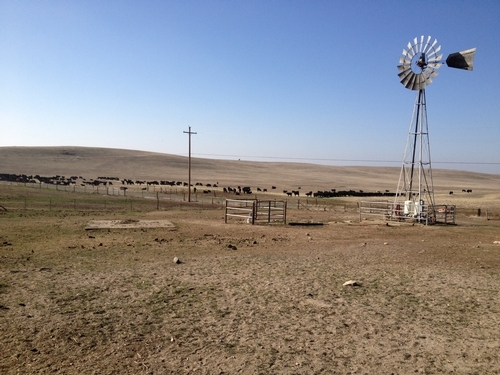"Drought and taxes have a lot in common. They are both facts of life that must be dealt with periodically, they are both pains in the neck, and they both carry serious consequences if we choose to ignore them." - Jeff Mosley, Extension Range Management Specialist, Montana State University, Bozeman.

As a result, producers over the years have developed strategies to cope with the inevitable effects of drought. Ranchers are tremendously affected by drought mainly because of their dependence on annual precipitation for forage production.
Drought affects ranchers through loss in forage production, water shortage, and higher prices and reduced availability of supplementary feed. In the past year alone, many workshops and web resources were put together to provide drought management tools and information for the ranching community. The Drought Management Workshop at the Sierra Foothills Research and Extension Center and the California Rangeland Watershed Laboratory website are two good examples.
Now may be the right time to look ahead and plan for the future. The two most important questions rangeland managers need to ask themselves are:
- What have we been doing well that we need to continue building upon?
- What changes do we need to make to improve future production, and maintain or improve resilience to future droughts?
This process can be daunting, but dividing the activities into short-term, medium-term and long-term categories may help make the planning process less overwhelming. This way, one can focus on a few activities at a time while building towards long-term resilience.
Short-term: The first year after a drought period, cow-calf producers will be focusing on rebuilding their herd. During this process, paying particular attention to herd genetics and health is critical. Rebuilding a herd after a severe drought may be a good opportunity to bring in new qualities that were previously missing. Examples of characteristics to consider include good mothering ability (weaning weight, early calving, calving ease), temperament, livestock that will not only survive, but thrive in your environment, animals suitable for your target markets and animals with a history of good health and management.
It may be a good idea to start slow with the herd-building process or stock lower than normal for stocker operations the first year after a drought. This is especially true for rangelands that had lower than the recommended residual dry matter (RDM) levels before the fall rains started. University of California researchers found that optimum RDM levels (old herbaceous plant biomass left before the fall rains) in annual rangelands tend to increase with slope and decreases with woody cover. Lower RDM is expected to result in lower than normal forage production and lower species richness. The first year after drought, ranchers may want to explore available drought or emergency programs (e.g. FSA programs) that may help in the process of rebuilding the herd or providing feed and water for their livestock.
Medium-term: Two to three years after drought, ranchers should continue building their herds, monitor rangeland condition and actively manage rangeland weeds, if any. During this period, livestock numbers can be increased to optimal levels because even annual rangelands that had lower RDM due to drought conditions are likely to be fully recovered from drought effects within three years. Starting or continuing a rangeland monitoring program to measure forage production and RDM is critical at this stage in order to generate information necessary to make management decisions.
Monitoring forage production, in the medium-term and eventually long-term, is important for setting conservative stocking rates. Weed management has to be one of the main priorities in any management programs, because drought conditions sometimes increase the risk for weed invasion. If left unchecked, weed invasion will reduce rangeland carrying capacity in the long-term by reducing rangeland nutritional value as weeds continue to replace preferred and more palatable species.
Long-term: The fourth year onwards is about building flexibility into the system to accommodate fluctuations in forage production over time that occur in these complex ecosystems. The more flexibility built into the system the more resilient the operation. A production system with different animal types, e.g. cow-calf and stockers, allows for more flexibility to increase livestock numbers during periods of good forage production and reduce numbers when drought conditions return. Going further to add other livestock species would make sense if conditions are ideal. This is the time to look for more options to increase grazing land, by leasing more land if available; and building relationships with suppliers of local agricultural bi-products that are good livestock feed. Alternative on-ranch enterprises like value-adding and agro-tourism could be options for some. Water availability in all pastures used during the dry season should be planned, to ensure reliable water is available for the livestock during dry seasons. Drought resilience tends to increase as a producer makes more effort to integrate drought management tools into the management plan.
Author - County Director Mariposa, Livestock and Natural Resources Advisor Mariposa, Merced Counties